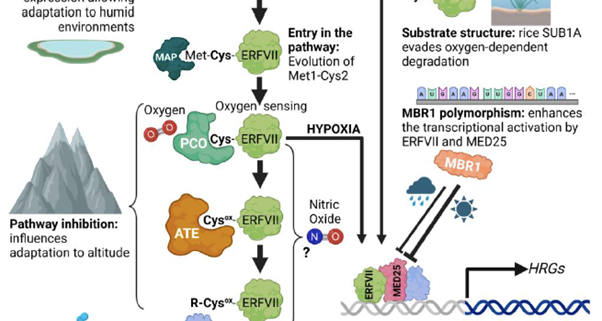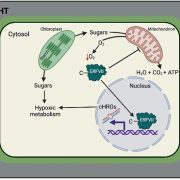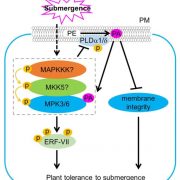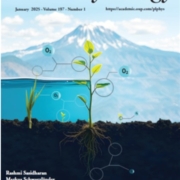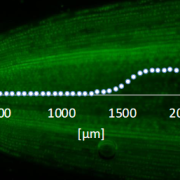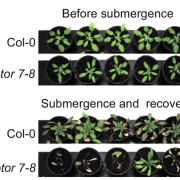Review: Geography, altitude, agriculture, and hypoxia
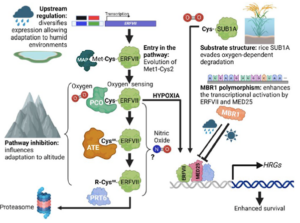 Hypoxia, or reduced oxygen availability, is a double-edged sword: while it disrupts metabolism and can cause cell death, it also plays a vital role in regulating development in animals and plants. With extreme flooding increasing due to climate change, understanding how genetic variation enhances hypoxia tolerance provides valuable strategies for improving crop resilience. This review by Holdsworth et al. examines how geography, altitude, and agriculture have shaped molecular responses to hypoxia, particularly through the PLANT CYSTEINE OXIDASE (PCO) N-degron pathway, and how these responses have evolved across different land plant species over time. Local adaptation plays a key role in acclimatization to humid environments, where flooding, often triggered by intense rainfall, drives acute hypoxic stress. Environmental genome-wide association studies (eGWAS) help identify genes linked to hypoxia tolerance by integrating large-scale genomic and environmental data. Altitude also influences oxygen-sensing adaptations, though no direct molecular mechanism for absolute altitude sensing has been identified. However, adaptation to altitude is at least partially linked to the PCO N-degron pathway. Agriculture has further shaped hypoxia responses, as seen in rice: the FR13A variety uses the Sub1A-1 gene to withstand full submersion by limiting growth and enhancing anaerobic metabolism, while deepwater rice employs SNORKEL1/2 genes to elongate stems and escape partial submersion. These insights drive breeding strategies for flood-resistant crops. Ultimately, understanding the conserved PCO N-degron pathway provides a foundation for future research into plant adaptation to low-oxygen environments, integrating georeferenced genomic data and biochemical findings. This article is part of the Plant Physiology focus issue on Hypoxia and Plants; a recorded webinar on this topic can be found here. (Summary by Elisa De Meo, www.linkedin.com/in/elisa-de-meo-25415a20b) Plant Physiol. https://doi.org/10.1093/plphys/kiae535
Hypoxia, or reduced oxygen availability, is a double-edged sword: while it disrupts metabolism and can cause cell death, it also plays a vital role in regulating development in animals and plants. With extreme flooding increasing due to climate change, understanding how genetic variation enhances hypoxia tolerance provides valuable strategies for improving crop resilience. This review by Holdsworth et al. examines how geography, altitude, and agriculture have shaped molecular responses to hypoxia, particularly through the PLANT CYSTEINE OXIDASE (PCO) N-degron pathway, and how these responses have evolved across different land plant species over time. Local adaptation plays a key role in acclimatization to humid environments, where flooding, often triggered by intense rainfall, drives acute hypoxic stress. Environmental genome-wide association studies (eGWAS) help identify genes linked to hypoxia tolerance by integrating large-scale genomic and environmental data. Altitude also influences oxygen-sensing adaptations, though no direct molecular mechanism for absolute altitude sensing has been identified. However, adaptation to altitude is at least partially linked to the PCO N-degron pathway. Agriculture has further shaped hypoxia responses, as seen in rice: the FR13A variety uses the Sub1A-1 gene to withstand full submersion by limiting growth and enhancing anaerobic metabolism, while deepwater rice employs SNORKEL1/2 genes to elongate stems and escape partial submersion. These insights drive breeding strategies for flood-resistant crops. Ultimately, understanding the conserved PCO N-degron pathway provides a foundation for future research into plant adaptation to low-oxygen environments, integrating georeferenced genomic data and biochemical findings. This article is part of the Plant Physiology focus issue on Hypoxia and Plants; a recorded webinar on this topic can be found here. (Summary by Elisa De Meo, www.linkedin.com/in/elisa-de-meo-25415a20b) Plant Physiol. https://doi.org/10.1093/plphys/kiae535


